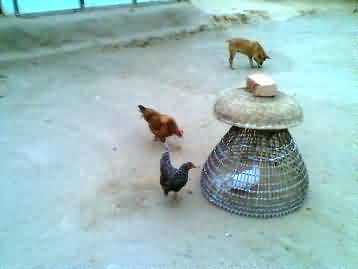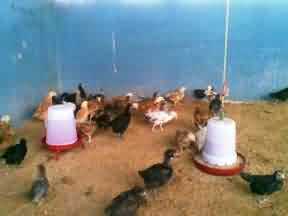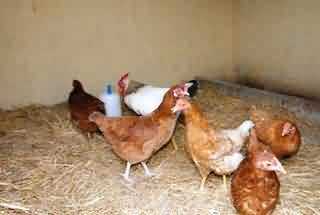पिछवाड़े मे पोल्ट्री फाम्रिगं - ग्रामीण किसानों के लिए बेहतर आजीविका का स्रोत

Backyard poultry production is an age old practice in rural India. Most of the backyard poultry production comprises rearing of indigenous birds with poor production performances.
The potentiality of indigenous birds in terms of egg production is only 70 to 80 egs/ bird/ year and meat production is also very less. However, the backyard poultry production can be easily boost up with improved varieties of chicken and can promise a better production of meat and egg.
To improve the socio-economic status of the traditional farmers, backyard poultry is a handy enterprise with low-cost initial investment, but high economic return along with guarantee for improving protein deficiency among the poor.
Why to go for backyard poultry farming?
- Low initial investment but higher economic return.
- A unit can be started with as low as two chickens to a large flock.
- Feed cost is negligible due to better utilization of agricultural by-products and leftover feed and grains.
- Egg and birds can be sold in local market with high price, because there is a growing demand for local chicken.
- And the consumers are willing to pay higher prices for high quality desi chicken meat or egg.
- Boost up in family income for better utilization of family laboures who are not able to perform other agricultural works like old family member or children.
- Backyard poultry farming acts as an ‘ATM’, because as per family need the birds and eggs can be sold at anytime anywhere with cash in hand.
- Quality of chicken and egg is better in terms of organic farming as the birds are raised in stress less environment with natural input.
Improved strain of poultry birds for backyard farming
Desi or indigenous birds are generally poor performers in egg and meat production. To obtain maximum profit from backyard poultry farming there is a urgent need in the country to improve the status of backyard poultry farming with improved strain of poultry birds, who performs an excellent result when raised in backyard with low inputs. Improved chicken that can be introduced in backyard poultry farming should have following characters-
- Adaptability in village condition
- Self propagation
- Good brooding capacity
- Mothering ability
- Well body conformation
- Hardy in nature
- Good scavengers
- Attractive and coloured plumage
- Escaping capacity from predators
- Disease resistance
Considering the above characteristics, the verities that can be recommended for backyard poultry farming are- Gramapriya, Vanaraja, Giriraja, Girirani, Krishna - J etc.
The annual egg production capacity of Gramapriya and Vanaraja birds are 200 to 220 and 200 to 230 egg/ bird/ year, respectively. First egg lays at 200 to 230 days depending on plane of nutrition and other managemental parameters. Egg weight varies from 55 to 60 gram. Mature body weight 2.5 to 3.5 kg.
Housing management for backyard poultry farming
No elaborate housing is required for backyard poultry farming but, it should protect the birds from sun, rain and predators. If free range system is practiced the birds are let loose in day time for foraging and at night sheltered in shed. For better production performances certain criteria that can be considered are –
- The poultry house should be in east-west orientation to protect from summer wind and cold stress and also for direct sunlight in winter months.
- During summer direct sun light should be avoided to reduce the summer stress in birds.
- Low cost housing material like wood, bamboo, grass, thatch etc can be utilized.
- The poultry house should be free from water seepage or moisture.
- Floor should be in elevated land or above ground level (minimum 2ft) and free from water crack, easily cleaned, rat proof and durable.
- There should be free air movement in upper part of the shed to reduce gas formation inside the shed.
- Height of the side wall in poultry house is generally 7 ft to 8 ft. The centre height is 9 ft to 12 ft with slope in either side.
- Roofing material like thatch, tiles, asbestos etc can be used.
- Brooder house should have easy ventilation and wire netting which is used for open air ventilation.
- Provision of bulb fitted above the ground as hoover may be utilized to keep the chicks worm.
Brooding of Chicks
There are two types of brooding viz. Natural brooding and Artificial brooding that can be adopted for backyard poultry farming.
Natural brooding
If natural brooding is practiced the local broody hen is used as the indigenous hens are very good sitters. Improved variety of fertile eggs is put into incubation. The hen is provided with nesting materials. Food and water supply is given throughout the incubation period.
A broody hen can easily take care for brooding and hatching of 12 to 15 chicks. After hatching the chicks are let loose along with mother for scavenging. There should be provision for separate place inside the shed for young chicks and mother at night.
Artificial brooding
In artificial brooding provision of artificial heat is necessary. Artificial heat can be provided with electricity, gas, kerosene, wood, sawdust etc. ‘Bukharies’ also can be used as a source of artificial heat. Wood, charcoal or sawdust is used in ‘Bhukaries’ and it is an ideal source of artificial heating when there is acute shortage of electricity, gas and kerosene.
The optimum temperature is 95⁰ F in first week and it can be reduced 5⁰F per week up to 6 week till 70⁰F. Two watt/ chick heat is required up to 6 week in brooder house.
The necessity of light in brooder house is to increase feed consumption for maximum growth in a short period and also to prevent stampeding or piling if scared. Initially (up to 6 weeks) there should be provision for at least continuous light up to 48 hours in brooder house and in growing stage (8 to 18 weeks) light hour is 10 to 12.
But in laying period light should be for 15 to 16 hours. The provision for extra light may be in the morning or evening or may be morning and evening both. To prevent direct contact with heat a chick guard made up of card board or metallic guard can be used in brooder house.
The height of chick guard is 15 to 18” is placed in circular shape at a distance of 3’ away from the hover.
Feeding management
The feed cost alone is 70% of total expenditure in poultry production. In backyard poultry farming the feed cost is considered to be minimum. Hence, the birds are let loose for scavenging in the open yard and collect the required protein, energy, minerals and vitamins etc from insects, snail, termites, seeds of grasses and weeds, leftover grains, crop residues and household wastes.
Feed ingredients like broken rice, ground nut straw, wheat or job’s tear grain, rice bean etc also can be given to the birds. During rainy season poultry feed should not be stored more than 1.5 months to avoid fungus growth (Aflatoxicosis). In backyard poultry farming generally two times feeding is practiced; once at morning and another at evening.
The space requirement for feeder is 2 to 7 cm at brooding period, 7 to 10 cm during growing stage and 12 to 15 cm / bird at laying stage. The water space should be 0.5 to 1.5 cm during brooding, 1.5 to 2.5 during growing and 2.5 cm during laying period.
The birds may be supplied with extra concentrate ration @ 30 to 60 gm/ day/ bird for better performance.
The balanced ration may be formulated with appropriate percentage of maize, rice polish, wheat bran, ground nut cake, fish meal, shell grit or lime stone along with salt, minerals and vitamins or may be with locally available ingredients. The poultry feed should contain at least 20% protein in starter level, 16% in grower and 18% in laying stage with energy level (ME) 2800 kcal/kg feed in starter, 2600 kcal/kg at grower and 2650 kcal/kg in layer ration.
Health care management
For better health care in backyard poultry farming the birds should be vaccinated against virus diseases in time. The diseases that mostly effect the birds are Ranikhet disease, Marek’s Disease, Fowl pox, Gumbroo disease etc.
Regular vaccination schedule may be followed in a poultry farm (Table 1). Deworming for internal and external parasites also should be done to maintain a healthy flock. Other diseases that may affect the poultry birds are Coccidiosis, infectious coryza, Salmonellosis etc.
Table 1. Vaccination schedule for poultry birds
|
Sl. No. |
Age of birds |
Name of Vaccine |
Name of Disease |
Doses |
Route of Vaccination |
|
1 |
Day old Chicks |
HVT MD Vaccine |
Marek’s Disease |
0.2 ml |
S/c or I/m |
|
2 |
4 to 7 days |
F-1/ Lasota |
Ranikhet Disease |
One drop |
Eye or nostril |
|
3 |
14 to 18 days |
Intermediate plus |
Gumboro disease |
- |
Drinking water |
|
4 |
35 days |
F-1/ Lasota |
Ranikhet Disease |
One drop |
Eye and nostril |
|
5 |
6 to 7 weeks |
Chicken embryo adopted |
Fowl Pox |
0.5 ml |
Wing stab method |
|
6 |
8 to 10 weeks |
Strain killed vaccine |
Ranikhet Disease |
0.5 ml |
S/c or I/m |
Finger tips suggestion for backyard poultry farming
- Disease free, improved strain, dual purpose poultry birds may be procured for back yard poultry farming.
- Periodical vaccination should be done on regular basis.
- Clean drinking water and fungus free feed should be supplied to the birds.
- The poultry shed should be regularly cleaned and free from moisture and humid condition.
- Overcrowding should be avoided.
- If possible there should be separate space for different age group of birds.
- Sick bird should be immediately separated/ culled from healthy flock.
- Poultry equipments particularly waterer and feeder should be regularly cleaned and disinfected.
- There should be restriction for outsider into the poultry shed or farm.
- The birds should be free from predators and should not be scared by other animals.
- Before procuring new flocks the shed should be thoroughly cleaned and disinfected.
- There should be provision for footbath in front of poultry shed.
- During summer and winter months the shed should be protected from hot or cold wind by hanging curtain around the side of the wall or shed. In summer months water sprinkling also can be done.
Authors:
¹ Dr Asit Chakrabarti, ² Dr Amitava Dey and ³ Dr S K Barari
¹ Senior Scientist (LPM),² Principal Scientist (AN) & Head, ³ Chief Technical Officer
Division of Livestock & Fishery Management
ICAR Research Complex for Eastern Region
ICAR Parisar, P.O. Bihar Veterinary College, Patna- 800014, Bihar
¹ Corresponding Author: E-mail:



